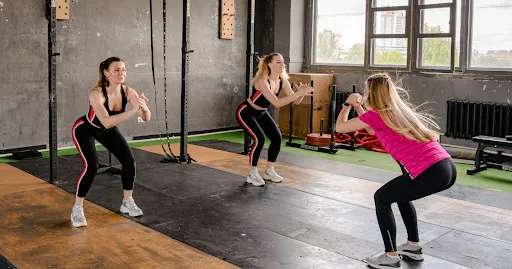PERSONAL TRAINING BLOG

Beginner-Friendly Isometric Routine for Stronger Muscles
Stronger Muscles and Pain-Free Joints with This Beginner-Friendly Isometric Routine
Blog Summary:
Build strength and reduce joint pain with this beginner-friendly isometric routine in Havertown, PA. These low-impact exercises improve muscle stability, posture, and mobility—perfect for all fitness levels. Start today and move pain-free with the Ultimate Wellness!
Muscle weakness and joint pain can make even simple daily activities challenging. Whether it’s difficulty climbing stairs, carrying groceries, or sitting for long periods, the discomfort affects your quality of life. Many people in Havertown, PA, and nearby towns like Drexel Hill and Broomall face these issues due to a sedentary lifestyle, lack of exercise, or past injuries. But there’s good news! At Ultimate Wellness Lifestyle, we believe in easy, effective solutions to help you regain strength and move pain-free.
Isometric exercises are a simple yet powerful way to build muscle strength and improve joint stability—all without heavy lifting or high-impact movements. If you’ve been looking for an exercise routine that supports joint health while helping you feel stronger, this beginner-friendly isometric routine is exactly what you need.
What Are Isometric Exercises?
Isometric exercises involve holding a position without moving your joints. Unlike traditional exercises where you lift or push weights, these exercises focus on muscle contraction in a fixed position. They help improve strength, stability, and endurance without stressing the joints.
Why Are Isometric Exercises So Effective?
Increases Muscle Strength: Engages muscles deeply, helping them grow stronger.
Support Joint Health: Strengthens the muscles around your joints to reduce pain and improve mobility.
Improve Posture and Stability: Helps with balance and core strength.
Safe for All Fitness Levels Perfect for beginners, seniors, or anyone recovering from an injury.
No Equipment Needed: Can be done anywhere, anytime, without weights or gym machines.
Great for Injury Recovery: Since they don’t involve movement, they allow muscles to strengthen without overexertion.
Beginner-Friendly Isometric Routine
This simple routine targets key muscle groups to improve strength and support joint health. Perform each exercise for 15-30 seconds and repeat 2-3 times. Gradually increase the hold time as you get stronger.
1. Wall Sit (Targets legs and core)
Stand against a wall with your feet shoulder width apart.
Slowly slide down until your knees form a 90-degree angle.
Keep your back pressed against the wall and hold.
Engage your core and thighs.
2. Plank Hold (Targets core, shoulders, and back)
Lie face down and lift your body onto your forearms and toes.
Keep your back straight and your core engaged.
Hold this position without dropping your hips.
Start with 15 seconds and increase as you progress.
3. Glute Bridge Hold (Targets glutes and lower back)
Lie on your back with your knees bent and your feet flat on the floor.
Lift your hips until your body forms a straight line from shoulders to knees.
Squeeze your glutes and hold.
Great for improving lower back stability.
4. Seated Knee Extension (Targets quadriceps and knee stability)
Sit in a chair with your feet flat on the ground.
Extend one leg straight out and hold it.
Lower slowly and switch legs.
Helps with knee pain and mobility.
5. Shoulder Press Hold (Targets shoulders and arms)
Hold your arms at 90 degrees as if pressing an invisible weight overhead.
Keep your elbows steady and engage your shoulders.
Strengthens the shoulders and improves posture.
6. Calf Raise Hold (Targets calves and ankle stability)
Stand with feet hip-width apart and slowly rise onto your toes.
Hold the position for 15-30 seconds.
Helps strengthen the lower legs and improve balance.
7. Side Plank Hold (Targets core and obliques)
Lie on your side and prop yourself up on one forearm.
Keep your body straight and hold the position.
Repeat on the other side.
Helps with balance and spine stability.
8. Hand Press Hold (Targets chest and arms)
Place your palms together in front of your chest.
Press them firmly against each other and hold.
Activates the chest muscles and strengthens the arms.
How Isometric Exercises Help with Joint Pain
Many people avoid exercise due to joint pain, but isometric exercises are gentle on the joints while strengthening the muscles around them. This added support reduces stress on the joints, improves mobility, and minimizes pain over time. If you struggle with knee pain, back pain, or arthritis, incorporating isometric exercises can help manage discomfort without overexertion.
Key Benefits for People with Joint Issues
Low-impact movements that don’t strain the joints.
Strengthens stabilizing muscles, improving mobility.
Reduces stiffness by keeping muscles engaged.
It can be done seated for those with severe pain.
How Often Should You Do Isometric Exercises?
For the best results, perform these exercises 3-4 times per week. If you are new to exercise or recovering from an injury, start slow and focus on holding each position for at least 15 seconds before increasing time.
Pair Isometric Exercises with a Healthy Lifestyle
Building strength isn’t just about exercise. To improve joint health, make sure you:
Eat a balanced diet rich in protein, healthy fats, and anti-inflammatory foods.
Stay hydrated to keep joints lubricated.
Get enough sleep for muscle recovery.
Stretch regularly to improve flexibility.
Make It a Part of Your Daily Routine
The best part? You don’t need a gym or any equipment! These exercises can be done anywhere—at home, at work, or even while watching TV. Small daily efforts lead to stronger muscles, better posture, and pain-free movement.
Who Can Benefit from Isometric Exercises?
Beginners looking for an easy routine
Seniors wanting to stay active without joint pain
People recovering from injuries
Office workers suffering from stiffness
Athletes wanting extra strength and endurance
Ready to Feel Stronger and Move Pain-Free?
It’s time to take control of your health with the Ultimate Wellness Lifestyle. Whether you live in Havertown, PA, Drexel Hill, or Broomall, this simple isometric routine can help you build strength and improve joint health—without heavy lifting or intense workouts.
Don’t wait! Start today and feel the difference. Visit Ultimate Wellness Lifestyle for more fitness and wellness tips!


ARE YOU READY TO INVEST IN YOUR HEALTH AND HAVE A BLAST AT ULTIMATE WELLNESS?!?!
IF SO, CLICK THE LINK BELOW TO LEARN MORE
15 B SOUTH EAGLE ROAD, HAVERTOWN, PENNSYLVANIA 19083
15 B SOUTH EAGLE ROAD,
HAVERTOWN, PENNSYLVANIA 19083
© 2025 Ultimate Wellness
|
|
© 2025 Ultimate Wellness

